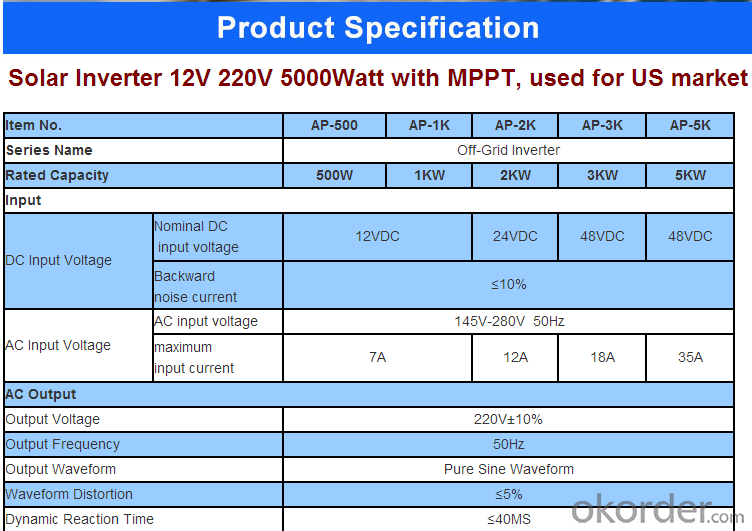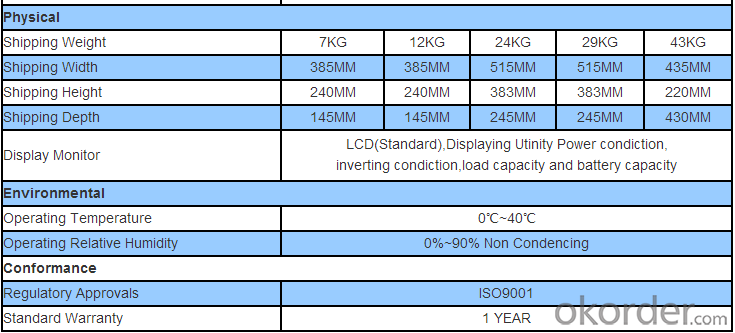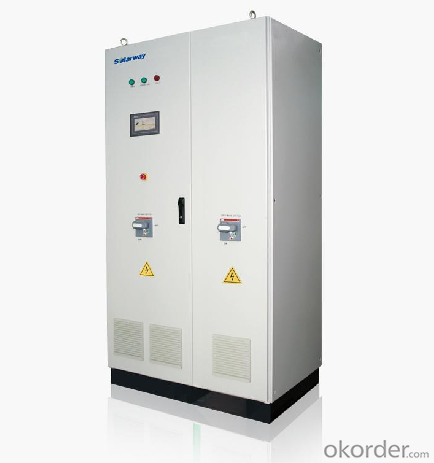PV On-Grid Inverterolar Inverter 12V 220V 5000Watt with MPPT
OKorder Service Pledge
OKorder Financial Service
You Might Also Like
Description:
CNBMSOLAR is a world-leading and Vertical integrated manufacturer of high-performance with Silicon,
Wafer, Cells, Modules, which convert sunlight into electricity for residential, commercial, and utility-scale
power generation.
The capacity of CNBMSOLAR is reach to 1GW, and make sure each year our shipment capacity is more
Than 700-800MWs, at the same time, we have set up the largest solar power station with our partner
in Ukraine.
CNBM is a Quality + Service oriented company with“Excellence at Each Step” approach, composed of
the finest components from TUV and IEC-certified partners around the world, CNBM modules consistently
undergo a variety of trials at the company’s Test & Development Centre, ensuring peak performance
capabilities. The company is committed to develop and provide the world with clean and renewable energy
to ease the energy shortages as well as human kind’s impact on the environment



FAQ:What's your products feature?
1. Pure sine wave Output, applicable in various field
2. More stable, safer industrial online system
3. CPU with dual core, Better performance.
4. Availability of wide range of input voltage, AVR available
5. Protection against overload, short circuit, over/lower voltage, over-heat
6. LED+LCD display, evident showing
7. Extended batteries group available for prolonging back-up time
8. Intelligent battery management with over-charge and over-discharge protection
9. Temperature controller adjusting cooling ventilation, reducing noise
10. High efficiency of transferring, diminishing energy loss, increasing stability
- Q:Can a solar inverter be used in areas with unstable grid power?
- Yes, a solar inverter can be used in areas with unstable grid power. In fact, solar inverters are often used in such areas to provide a stable and reliable power supply. The inverter's ability to convert solar energy into usable electricity allows it to function independently of the grid power, ensuring a continuous power supply even during grid outages or fluctuations.
- Q:Are there any noise or sound considerations with a solar inverter?
- Yes, there are noise considerations with a solar inverter. While solar inverters generally produce low levels of noise, there can be some audible humming or buzzing sound generated during their operation. The noise level can vary depending on the type and model of the inverter. However, modern inverters are designed to minimize noise and are generally considered to be quiet during normal operation.
- Q:What is maximum power point tracking (MPPT) in a solar inverter?
- Maximum power point tracking (MPPT) is a technique used in solar inverters to optimize the power output of a photovoltaic (PV) system. Solar panels generate electricity when exposed to sunlight, and their power output varies depending on factors such as temperature, shading, and the angle of incidence of sunlight. The maximum power point (MPP) is the point at which a solar panel generates the maximum amount of power for a given set of environmental conditions. However, since these conditions are constantly changing, it is essential to continuously track the MPP to ensure the highest possible power output from the solar panels. A solar inverter with MPPT functionality utilizes advanced algorithms and electronics to continuously monitor the voltage and current output of the solar panels. By dynamically adjusting the operating voltage and current to match the MPP, the MPPT inverter ensures that the solar panels operate at their highest efficiency, regardless of the changing environmental conditions. When the solar panels are operating at their MPP, the MPPT inverter extracts the maximum amount of power from the panels and converts it into usable AC power. This optimization leads to higher overall energy generation and maximizes the return on investment for solar power systems. In addition to improving efficiency, MPPT also offers other advantages. It can compensate for fluctuations in solar irradiation, temperature, or shading that may affect the power output of the panels. By continuously tracking the MPP, the MPPT inverter adjusts the operating parameters to mitigate the impact of these factors, ensuring a consistent and optimal power output. Overall, MPPT is a crucial feature in solar inverters as it maximizes the power output of a PV system by continuously tracking and adjusting the operating parameters to match the MPP. This technology enables solar power systems to operate at their highest efficiency, enhance energy generation, and maximize the benefits of utilizing renewable energy sources.
- Q:Can a solar inverter be used with different types of solar PV systems (roof-mounted, ground-mounted, etc.)?
- Yes, a solar inverter can be used with different types of solar PV systems, including roof-mounted and ground-mounted systems. Solar inverters are designed to convert the DC (direct current) electricity generated by solar panels into AC (alternating current) electricity that can be used in homes or fed back into the grid. Regardless of the installation type, the solar inverter's function remains the same.
- Q:Can a solar inverter be used in regions with high levels of air pollution?
- Yes, a solar inverter can be used in regions with high levels of air pollution. The performance of the solar inverter may be slightly affected due to the reduced sunlight reaching the solar panels, but it can still convert the available solar energy into usable electricity. Regular maintenance and cleaning of the solar panels may be required to mitigate the impact of air pollution on their efficiency.
- Q:Can a solar inverter be used with different types of energy management systems?
- Yes, a solar inverter can be used with different types of energy management systems. Solar inverters are designed to convert the direct current (DC) produced by solar panels into alternating current (AC) that can be used in various electrical systems. They can be integrated with different energy management systems, such as battery storage systems, smart grids, or even hybrid systems that combine solar power with other renewable energy sources. This flexibility allows for efficient and optimized utilization of solar energy in different setups and applications.
- Q:Can a solar inverter be used with different grid voltages?
- No, a solar inverter cannot be used with different grid voltages. Solar inverters are designed to convert the DC power generated by solar panels into AC power that matches the voltage and frequency of the grid it is connected to. Using a solar inverter with different grid voltages can result in inefficient operation or even damage to the inverter. It is important to ensure that the solar inverter is compatible with the specific grid voltage before installation.
- Q:Are there any government incentives available for solar inverters?
- Yes, there are government incentives available for solar inverters in many countries. These incentives are aimed at promoting the adoption of renewable energy and reducing carbon emissions. One common incentive is the solar investment tax credit (ITC) in the United States, which allows homeowners and businesses to deduct a percentage of their solar installation costs from their federal taxes. In some countries, such as Germany, there are feed-in tariffs that require utility companies to pay a premium for the electricity generated by solar inverters. Additionally, some local governments offer grants or rebates for installing solar inverters or offer low-interest loans to finance the purchase and installation of the equipment. It is important to check with your local government or relevant authorities to understand the specific incentives available in your region.
- Q:Can a solar inverter be used in areas with high dust and dirt accumulation?
- Yes, it is possible to use a solar inverter in areas where there is a high accumulation of dust and dirt. However, it is important to take specific precautions and maintenance measures to guarantee its proper operation. Over time, dust and dirt can build up on the surface of the solar panels, causing a decrease in their efficiency. This can also have an impact on the performance of the solar inverter, as it relies on the energy produced by the solar panels. To minimize the impact of dust and dirt, it is essential to regularly clean the solar panels. This can be accomplished by using a gentle brush or sponge along with a mild detergent mixed with water. It is important to avoid using abrasive materials or applying excessive water pressure, as this may cause damage to the panels. Additionally, installing the solar panels at an angle and orienting them towards the sun can aid in reducing the accumulation of dust and dirt. Furthermore, some solar inverters are designed with built-in protection against dust and dirt. These inverters typically have IP65 or higher ratings, which indicates that they are dust-resistant and capable of withstanding water jets. Opting for such inverters can provide an extra layer of protection against the negative effects of dust and dirt accumulation. Overall, while it is possible to use a solar inverter in areas with high dust and dirt accumulation, regular maintenance and proper cleaning of the solar panels are crucial to ensure optimal performance and longevity of the system.
- Q:Can a solar inverter be used in a solar-powered air conditioning system?
- Yes, a solar inverter can be used in a solar-powered air conditioning system. A solar inverter converts the direct current (DC) produced by solar panels into alternating current (AC), which is required to power most appliances including air conditioning units. By using a solar inverter, the solar energy generated by the panels can be efficiently utilized to run the air conditioning system, reducing reliance on the electrical grid and lowering energy costs.
1. Manufacturer Overview |
|
|---|---|
| Location | |
| Year Established | |
| Annual Output Value | |
| Main Markets | |
| Company Certifications | |
2. Manufacturer Certificates |
|
|---|---|
| a) Certification Name | |
| Range | |
| Reference | |
| Validity Period | |
3. Manufacturer Capability |
|
|---|---|
| a)Trade Capacity | |
| Nearest Port | |
| Export Percentage | |
| No.of Employees in Trade Department | |
| Language Spoken: | |
| b)Factory Information | |
| Factory Size: | |
| No. of Production Lines | |
| Contract Manufacturing | |
| Product Price Range | |
Send your message to us
PV On-Grid Inverterolar Inverter 12V 220V 5000Watt with MPPT
OKorder Service Pledge
OKorder Financial Service
Similar products
New products
Hot products
Hot Searches
Related keywords






























